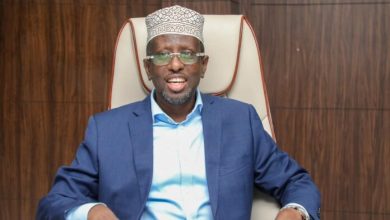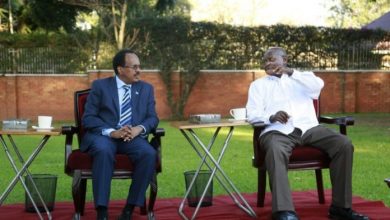Derek Chauvin guilty of murder, manslaughter in death of George Floyd
Former Minneapolis police officer Derek Chauvin has been convicted of murder and manslaughter in the death of George Floyd, which was captured on video and sparked worldwide protests over racism and police brutality.
Former Minneapolis police officer Derek Chauvin has been convicted of murder and manslaughter in the death of George Floyd, which was captured on video and sparked worldwide protests over racism and police brutality.
Chauvin had been charged with second-degree unintentional murder, third-degree murder and second-degree manslaughter in connection with Floyd’s death. A jury found him guilty on all three counts Tuesday afternoon.
Floyd died on May 25, 2020, after Chauvin pressed his knees on his neck and back for more than nine minutes as two other officers held him face-down on the pavement while he was handcuffed. He had been detained outside a convenience store on suspicion of paying with a counterfeit bill.
The jury has reached a verdict in the murder trial of former Minneapolis police officer Derek Chauvin, who is charged with killing George Floyd, a 46-year-old Black man who died while being restrained by police during an arrest last May.
Chauvin, who is white, is charged with second-degree unintentional murder, third-degree murder and second-degree manslaughter.
The verdict, reached after about 10 hours of deliberations over two days, is expected to be read late Tuesday afternoon.
The outcome of the high-profile trial at the Hennepin County District Court has been closely watched across the U.S. and around the world. Video of Floyd’s arrest captured by a bystander prompted widespread outrage, setting off protests over racism and police brutality.
Minneapolis has been on high alert since the jurors began their deliberations on Monday, preparing for potential violence in the event of an acquittal. The city has also been on edge in recent days over the deadly police shooting of a 20-year-old Black man, Daunte Wright, in a nearby suburb on April 11.
newsinisdeFloyd died on May 25, 2020, after Chauvin pressed his knee on his neck and back for more than nine minutes as two other officers held him face down on the pavement while he was handcuffed. He had been detained outside a convenience store on suspicion of paying with a counterfeit bill.
What the jury had to consider
The diverse jury, consisting of four Black people, four white people and two who identified themselves as multiracial, had been deliberating since late Monday afternoon, sifting through 14 days worth of evidence that included scores of exhibits, video and testimony from 45 witnesses, most of whom were called by the prosecution.
Chauvin chose not to testify, invoking his Fifth Amendment right not to do so.
The task for the prosecution was to convince the jury that Chauvin’s actions were a “substantial causal factor” in Floyd’s death and that his use of force was unreasonable.
To secure a conviction on the second-degree unintentional murder charge, prosecutors had to prove Chauvin caused Floyd’s death while committing or attempting to commit a felony. In this case, the jurors had to determine whether Chauvin’s knees pressed into Floyd’s neck and back was a third-degree assault.
However, as the charge states, the death can be unintentional, meaning the prosecution wasn’t required to prove that Chauvin intended to kill Floyd. Nor did it have to prove that no other factors contributed to his death.
For the third-degree murder charge, prosecutors had to convince the jury that Floyd’s death was caused by an act that was obviously dangerous, though not necessarily a felony.
The manslaughter charge had the lowest bar, requiring proof that Chauvin caused Floyd’s death through negligence that created an unreasonable risk and consciously took the chance of causing severe injury or death.
What the witnesses had to say
Court heard from several prosecution medical witnesses who testified that Floyd died of positional asphyxia, meaning his oxygen was cut off during his restraint by police.
The state also elicited testimony from use-of-force experts, including from within the city’s own police force. Several of them agreed the actions of Chauvin, who had been trained in use-of-force tactics, were excessive.
The city’s police chief, Medaria Arradondo, testified that Chauvin violated police policy and should have stopped kneeling on Floyd once Floyd had stopped resisting and signalled he was in distress.
Video evidence key
Perhaps the most-powerful pieces of evidence the prosecution relied on were the videos, from bystanders, police body cameras and surveillance cameras, showing Floyd pressed to the pavement, pleading that he couldn’t breathe, before he eventually became unresponsive and police were heard saying they couldn’t find a pulse.
That evidence included the video, shot by a teenage bystander, showing Chauvin pressing his knees into Floyd for nine minutes and 29 seconds, a period of time the prosecution repeatedly referred to in its closing argument.
But in his closing argument, Chauvin’s defence lawyer, Eric Nelson, argued that the case had to be analyzed from a wider perspective than that time frame focused on by the prosecution.
He said jurors had to take into account the time before those nine minutes, including the struggle the police had with Floyd as they attempted unsuccessfully to get him into a squad car.
He said all the evidence showed that Chauvin was following both his training and Minneapolis police department policies. A use-of-force expert called to the stand by the defence testified that Chauvin was justified in his actions.
As for the cause of death, the defence argued Floyd died as a result of his pre-existing heart condition combined with the drugs fentanyl and methamphetamine in his system and the adrenaline rush from his interaction with police. Other contributing factors cited by the defence included carbon monoxide from the exhaust of a nearby squad car.





